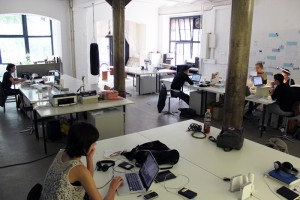By Cutright Elizabeth on July 19, 2016 in Coworking News
Creating an optimal work environment can prove daunting. It’s of ten impractical – and prohibitively expensive – to provide each employee with their own private domain. On the other hand, the surprisingly popular open office strategy has been shown to negatively impact productivity and morale.
ten impractical – and prohibitively expensive – to provide each employee with their own private domain. On the other hand, the surprisingly popular open office strategy has been shown to negatively impact productivity and morale.
So what’s the solution for distracted staff and budget-conscious employers?
In a 2014 dispatch for The New Yorker, Maria Konnikova laid out all the negatives of the wall-less workspace in “The Open-Office Trap.” Konnikova begins with a brief history of the open office, which originated in 1950s Germany and has spread to over 70% of offices worldwide. This wide-scale adoption runs counter to mounting evidence open office space increases stress, reduces productivity and leaves personnel feeling resentful and dissatisfied.
Much of the adverse effects of an open office can be traced back to the psychological need for privacy and control. In fact, a 2005 study revealed, “the ability to control environment had a significant effect on team cohesion and satisfaction.” Additionally, in a 2011 survey by organizational psychologist Matthew Davis, open offices were found uncontrolled interactions with coworkers created “higher levels of stress, and lower levels of concentration and motivation.”
Noise, of course, is yet another drawback of the open office plan. Overhearing phone calls and being subjected to unsolicited comments are just some of the challenges presented by the barrier-free workstation. Konnikova cites several studies indicating noise can result in both physical and psychological symptoms. For example, unwelcome sound adversely influences cognitive function and mental recall, and can even trigger the “fight-or-flight” response.
So what’s the solution?
Over at Slate, associate editor L.V. Anderson proposes a few simple ways to reign in the chatter and clamor rumbling unabated across desks and workstations. Anderson advises employers take advantage of instant messaging apps to encourage quieter communication. One solution is to option, arrange meeting spaces for group activities. Gatherings or small tête-à-têtes can take place during a walk around the building. Bosses can also designate quiet hours and offer private rooms for phone calls.
Another option involves reintroducing personal control into the workday. For example, one study conducted by GPS manufacturer MapOn looked at the different ways to eliminate unwanted interactions, increase productivity and enhance job satisfaction. During the study, MapOn’s programmers – a position requiring large blocks of uninterrupted time – used three methods to designate they were not to be disturbed: a sign, earphones, and Luxafor, a programmable light that shines red whenever a worker does not want to be bothered.
All three methods functioned reasonably well during the first week and half of the study. Nevertheless, within a fortnight, the sign proved ineffective – in part because the programmers themselves often forgot to deploy it. The headphones and Luxafor, on the other hand, continued to be successful after month of use, with disruptions and undesired interactions reduced by almost 75%.
While it’s clear open offices won’t be retired anytime soon, many companies are beginning to offer a multitude of options to help their wage-earners cope with an unfettered work environment. Many have found that providing peaceful spaces and encouraging situational awareness can go a long way towards improving morale and mitigating the negatives.
For example, when Inc. CEO Howard Tullman noticed his coworkers wandering around, laptops in hand, in search of some privacy, he realized “These sad sojourns for solace and silent spaces are actually pretty clear statements that we need to rethink the latest spatial strategies and–at a minimum–start thinking about segmenting and segregating spaces.”
“There’s something frighteningly productive about a little peace and privacy that we’ve seemingly lost sight of.”


